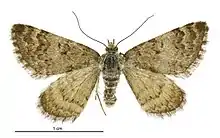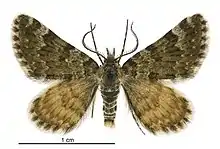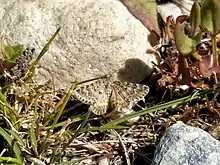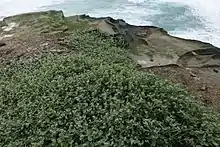Paranotoreas fulva
Paranotoreas fulva is a species of moth in the family Geometridae. This species is endemic to New Zealand. It is classified as "At Risk, Relict" by the Department of Conservation.
| Paranotoreas fulva | |
|---|---|
 | |
| Female | |
 | |
| Male | |
| Scientific classification | |
| Kingdom: | Animalia |
| Phylum: | Arthropoda |
| Class: | Insecta |
| Order: | Lepidoptera |
| Family: | Geometridae |
| Genus: | Paranotoreas |
| Species: | P. fulva |
| Binomial name | |
| Paranotoreas fulva | |
| Synonyms[2] | |
| |
Taxonomy
This species was first described and illustrated by George Vernon Hudson in 1905 and was given the name Lythria fulva.[1] Hudson used a specimen collected at about 3500 ft at Wedderburn, Central Otago by J. H. Lewis.[3][2] Hudson discussed and illustrated this species in his 1928 book The Butterflies and Moths of New Zealand under the name Notoreas fulva.[4][2] In 1986 Robin C. Craw proposed placing this species within the genus Paranotoreas.[5] The lectotype specimen, collected at Wedderburn, is held at the Museum of New Zealand Te Papa Tongarewa.[2]
Description
.jpg.webp)
Hudson described the species as follows:
The expansion of the wings is 3⁄4in. The fore wings are dull grey-ish brown, greenish-tinged. There is a wavy darker band near the base ; a broad median band with a strong rounded projection towards the terman above middle ; a dull greenish band on termen preceded by row of pale dots on veins, cilia grey with blackish bars. The hind wings are dull reddish-ochreous. There are three very obscure blackish transverse lines. The cilia are grey, faintly barred with darker.[3]
This species varies in depth of colouring on its fore and hind wings with some female specimens being extremely pale and having forewings that are coloured reddish-ochreous.[4]
Distribution
This species is endemic to New Zealand.[6] As well as the type locality, this species has also been found in Alexandra.[4] P. fulva also occurs in the Manorburn Ecological District,[7] as well as at Pisa Flats, Chapman Road Scientific Reserve, Springvale Junction, Moa Creek and other sites in Otago[8] and South Canterbury.[9]
Life cycle and behaviour

The adults of this species are day flying.[9] Adults have been recorded on the wing in March, October and December.[4][10] They are known to sunbath on the bare salt pan soil of their favoured habitat.[11]
Habitat and host species

This species occurs in the salt pans of Otago,[8][12] as well as at tussock grassland areas of montane South Canterbury.[9] This species has also been collected on glacial outwash terraces south of Tekapo.[13] Atriplex buchananii and Plantago coronopus have been recorded as the larval host plants of this species.[14] Larvae of P. fulva have been reared on Stellaria gracilenta and species in the genera Crepis and Hieracium.[14]
Conservation status
This moth is classified under the New Zealand Threat Classification system as being "At Risk, Relict".[15] This species is under threat as a result of loss of habitat upon which it relies.[9]
References
| Wikimedia Commons has media related to Paranotoreas fulva. |
- "Paranotoreas fulva (Hudsona, 1905)". www.nzor.org.nz. Landcare Research New Zealand Ltd. Retrieved 2018-05-17.
- Dugdale, J. S. (1988). "Lepidoptera-annotated catalogue, and keys to family-group taxa" (PDF). Fauna of New Zealand. 14: 207 – via Landcare Research New Zealand Ltd.
- Hudson, G. V. (1905). "On some new species of macrolepidoptera in New Zealand". Transactions and Proceedings of the New Zealand Institute. 37: 355–358 – via Biodiversity Heritage Library.
- Hudson, G. V. (1928). The Butterflies and Moths of New Zealand. Wellington: Ferguson & Osborn Ltd. p. 127.
- Craw, R.C. (5 January 2012). "Review of the genus Notoreas (sensu auctorum) (Lepidoptera: Geometridae: Larentiinae)". New Zealand Journal of Zoology. 13 (1): 131–140. doi:10.1080/03014223.1986.10422654.
- Gordon, Dennis P., ed. (2010). New Zealand inventory of biodiversity: Kingdom animalia : chaetognatha, ecdysozoa, ichnofossils. Vol. 2. p. 461. ISBN 978-1-877257-93-3. OCLC 973607714. OL 25288394M. Wikidata Q45922947.
- Patrick, B.H. (1989). Lepidoptera, Cicadidae, Acrididae of the Manorburn Ecological District (PDF). Wellington, N.Z.: Department of Conservation. ISBN 0-478-01144-X. Retrieved 18 May 2018.
- Allen, R.B.; McIntosh, P.D. (1997). Guidelines for conservation of salt pans in central Otago (PDF). Wellington, N.Z.: Department of Conservation, New Zealand. ISBN 0478018975. Retrieved 18 May 2018.
- Patrick, Brian H. (2006). "Conservation of New Zealand's tussock grassland moth fauna". docslide.com.br. Retrieved 2018-05-18.
- "Paranotoreas fulva". iNaturalist. Retrieved 2022-02-28.
- "Chapman Road Scientific Reserve". www.doc.govt.nz. Retrieved 2022-02-28.
- Patrick, Brian (October 1989). "Panbiogeography and the amateur naturalist with reference to conservation implications". New Zealand Journal of Zoology. 16 (4): 749–755. doi:10.1080/03014223.1989.10422931.
- B. H. Patrick (January 1992). "Supplement to the Lepidoptera of the Mackenzie Country with recommendations on their conservation" (PDF). New Zealand Entomologist. 15 (1): 48–58. doi:10.1080/00779962.1992.9722629. ISSN 0077-9962. Wikidata Q57483707. Archived from the original (PDF) on 9 February 2013.
- "Paranotoreas fulva (Hudson, 1905)". plant-synz.landcareresearch.co.nz. 2009. Retrieved 2022-02-28.
{{cite web}}: CS1 maint: url-status (link) - Hoare, R.J.B.; Dugdale, J.S.; Edwards, E.D.; Gibbs, G.W.; Patrick, B.H.; Hitchmough, R.A.; Rolfe, J.R. (2017). Conservation status of New Zealand butterflies and moths (Lepidoptera), 2015 (PDF). Wellington, New Zealand: New Zealand Department of Conservation. p. 8. ISBN 9781988514383.
